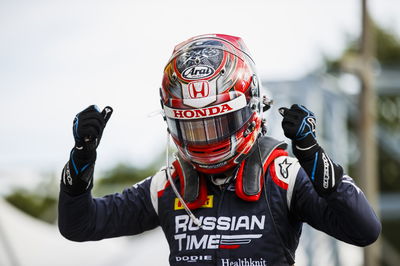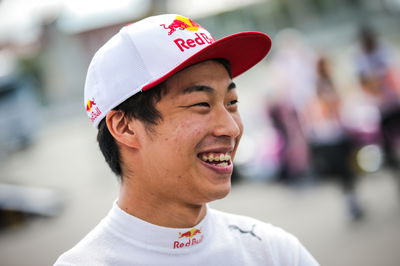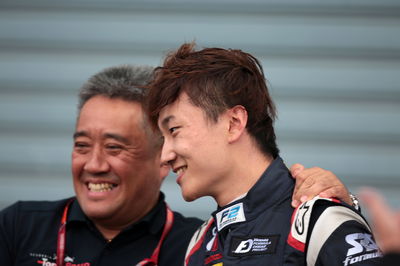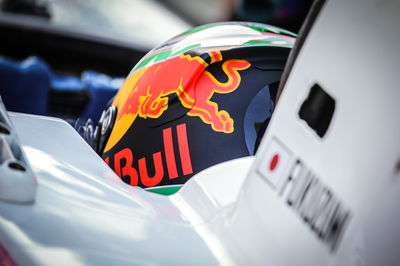The race to become Japan’s next F1 hero
One of the off-track highlights of attending the Japanese Grand Prix weekend at Suzuka is roaming around the fan area outside of the paddock, which is unrivalled for atmosphere in Formula 1.
I wrote last week how Japan truly does have F1’s “best fans”, who come out in their tens of thousands for the race weekend at Suzuka, adorning all kinds of home-made merchandise and costumes.

One of the off-track highlights of attending the Japanese Grand Prix weekend at Suzuka is roaming around the fan area outside of the paddock, which is unrivalled for atmosphere in Formula 1.
I wrote last week how Japan truly does have F1’s “best fans”, who come out in their tens of thousands for the race weekend at Suzuka, adorning all kinds of home-made merchandise and costumes.
One of the most noticeable shifts in the fan zone this year was the huge rise in Toro Rosso interest, sparked by the team’s new engine deal with Honda for this year. A Toro Rosso STR13 stood in the fan zone for pictures - in the place last year’s McLaren was - and the cheers that went up in the pre-race driver parade for Brendon Hartley and Pierre Gasly were the biggest of the day.
In the absence of a home driver to cheer on, Hartley and Gasly represent the next-best thing, racing with Honda power. Next year, Max Verstappen and Daniil Kvyat will also enjoy the support of the partisan crowd - but there will be no Japanese driver.
Not since Kamui Kobayashi raced for Caterham in 2014 have Japanese fans had a home driver to cheer on. But there are hopes that this will change in the not-too-distant future.
Honda had a number of goals upon its return to F1 as an engine supplier in 2015, one of them being to help nurture future Japanese talent with the hope of getting one of its supported drivers onto the grid. Nobuharu Matsushita enjoyed backing through the McLaren years, but took only three sprint race wins in GP2/Formula 2 before heading back to Super Formula for 2019.
As of 2018, though, there are two Japanese drivers racing in F2, both backed by Honda: Tadasuke Makino and Nirei Fukuzumi.
Fukuzumi is the driver closest to making the step up to F1 in terms of Super License points, with 21 to his name following his third-place finish in GP3 last year. A top-four finish in F2 this year would have been good enough to get him to the magic number of 40, but with two races remaining in Abu Dhabi, he sits 17th in the standings.

Fukuzumi is the most senior member of Red Bull’s junior programme too, having been signed following the agreement of the Honda deal earlier this year. With the support of the system that has helped a number of drivers reach F1, it is hoped he can be the next driver to fly the flag for Japan.
Makino’s rise has been more rapid than Fukuzumi’s over the past few years. He didn’t race a single-seater until 2015, when he finished second in the Japanese F4 championship, before making strides to Japanese F3, European F3 and finally F2 in the years that followed.
But his outstanding moment came at Monza earlier this year, when he claimed a shocking and stunning victory in the F2 feature race. A stroke of genius on tyre strategy saw him charge from 14th on the grid to the front of the pack in just five laps en route to a comfortable victory against one of the most talented fields the category has seen in years.
These kinds of shoots of brilliance are what gave Honda confidence to support Makino’s rise, much of which was sparked by a superb debut showing in Super GT back in 2016. While he may still only be 13th in the points heading to Abu Dhabi, Makino has time on his side in F2 given his quick rise. His Russian Time teammate, Artem Markelov, is proof that often the best way to develop is to learn in the toughest and highest-level championship you can.
The timing hasn’t quite worked out for Honda’s proteges, though. 2019 would be a prime time to slot a Japanese driver in at Toro Rosso given the team’s apparent shortage of drivers, prompting it to recall Kvyat a year after ditching him. Alas, neither Fukuzumi or Makino are ready for F1 just yet.
For the long-term, though, it remains a key aim for Honda. “Obviously to have a Japanese driver on the Formula 1 grid is very important for Japan and for ourselves for the future of this motorsport in Japan,” Honda F1 chief Masashi Yamamoto said at Suzuka.

“Regarding Makino and Fukuzumi. As you know, [Makino] has won in Monza. The series that they run in, the teams have been working with the new regulations, a lot of changes, trying rolling starts etc., so it hasn't been a very stable series.
“But they are both very good drivers, and we are educating them for a bright future.”
2019 will be a crucial year for the development of both drivers, be it if they stay in F2 or move across to Super Formula. If either can impress, then a place on the grid down the line is surely a given as Honda pushes to achieve another of its big goals for the current F1 project.
A Japanese driver on the grid would only act to stoke the already-brightly-burning fire for F1 in Japan. Even at Suzuka last weekend, hundreds of people were present for Fukuzumi and Makino’s appearances on the main stage in the fan area, eager to listen and get a glimpse of who may prove to be their nation’s future F1 heroes.
As we consider the future of the F1 grid and the Red Bull-Honda alliance, keep a close eye on the upcoming Japanese racers who are part of the project. Chances are they will be in heavy contention for a seat once their time comes around.












